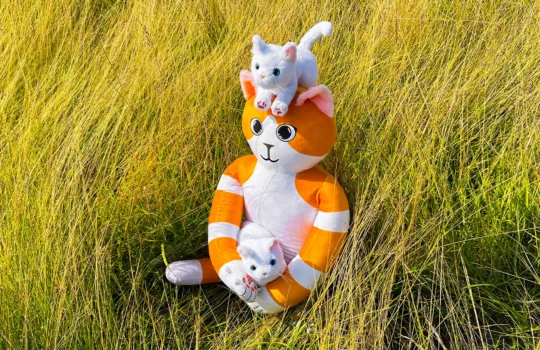The Benefits of Weighted and Hugging Plush Toys for Children
In recent years, weighted and hugging plush toys have gained popularity as effective tools for helping children manage anxiety, sensory issues, and emotional regulation. These toys, designed with special features like added weight or a cuddly embrace, provide both physical comfort and emotional support. But how exactly do they help children, especially those with anxiety or autism spectrum disorder (ASD)? Let’s explore the therapeutic benefits of these comforting companions.
What Are Weighted and Hugging Plush Toys?
Weighted plush toys are designed to provide gentle, deep pressure stimulation, mimicking the feeling of a comforting hug. They are typically filled with materials like glass beads or other weighted substances, offering a sense of calm and security. On the other hand, hugging plush toys are designed to be enveloping, often with soft, cushion-like features that simulate the embrace of a hug.
Both types of toys offer tactile comfort, helping children feel more grounded and secure in situations that might otherwise overwhelm them. When used together, they can provide both emotional and sensory support.
How These Benefit Children with Anxiety
Children with anxiety often struggle to manage overwhelming emotions, leading to feelings of stress and distress. Research shows that deep touch pressure (DPT), like the kind provided by weighted plush toys, can trigger the body’s parasympathetic nervous system. This system is responsible for helping the body relax and calm down.
A study published in the Journal of Sleep Medicine & Disorders explains how deep touch pressure can lead to an increase in serotonin and melatonin levels, which are neurotransmitters that help regulate mood and sleep. In turn, these neurotransmitters help reduce anxiety levels and promote a sense of well-being.
When children hug a plush toy, the physical sensation can help them self-regulate their emotions, providing relief during moments of anxiety. Hugging or holding a weighted plush toy may help soothe their nervous system and create a feeling of safety, which is especially crucial when they experience heightened emotions or sensory overload.
The Role of Weighted and Hugging Plush Toys for Children with Autism
For children with autism spectrum disorder (ASD), sensory processing issues are a common challenge. Many children with ASD experience heightened sensitivity to touch, sound, light, and even social stimuli. As a result, they may find certain situations overwhelming or distressing.
Weighted plush toys, due to their deep pressure, can offer a comforting sensory experience for children with ASD. The calming effect of these toys helps children with sensory sensitivities feel more grounded and focused. Research from the Journal of Autism and Developmental Disorders highlights how pressure-based sensory interventions can help children with autism manage stress and anxiety, improving their ability to engage with the world around them.
Hugging plush toys also provide a gentle, non-threatening source of tactile comfort. For children who are not yet able to communicate their emotional needs effectively, these toys act as a source of emotional regulation, offering a safe and predictable way to self-soothe.
Why Weighted and Hugging Plush Toys Are Effective for Emotional Support
- Providing Predictability: Both types of toys give children something consistent and familiar to hold on to, especially when they’re feeling anxious or overwhelmed. The predictability of the toy’s comforting presence can help soothe their nerves.
- Encouraging Emotional Regulation: When children feel out of control, having a weighted or hugging plush toy to rely on helps them self-regulate their emotions. This can be particularly helpful in moments of transition or change, such as during school or at bedtime.
- Promoting Sensory Integration: Weighted toys help with sensory integration by providing proprioceptive input (feedback from muscles and joints). This type of input helps children with sensory processing issues better process and respond to the world around them.
- Offering Safety and Comfort: A plush toy that mimics the feeling of a hug provides emotional security for children. Many children, especially those with ASD, find comfort in physical touch but may not always have access to a person who can provide it. A hugging plush toy fills this gap.
What Parents Need to Know Before Choosing
While these toys offer a variety of benefits, it’s important for parents to consider a few key factors before introducing them to children:
- Weight Considerations: For weighted toys, it’s crucial to select the appropriate weight based on the child’s size and age. Experts recommend that the weight of a weighted toy should be around 10% of the child’s body weight, though this can vary based on individual preferences and needs.
- Safety and Durability: Ensure that the plush toy is well-made, with secure stitching and safe materials. For children who tend to chew on toys, it’s essential to choose one that is durable and free from harmful chemicals.
- Monitoring Use: Though these toys are designed to provide comfort, it’s important to supervise their use, especially with younger children, to ensure they don’t become a safety hazard.
Valuable Emotional and Sensory Support
Weighted and hugging plush toys offer valuable emotional and sensory support for children, particularly those dealing with anxiety and autism spectrum disorder. These toys not only provide a sense of comfort through deep pressure and physical warmth, but they also help children build emotional resilience and manage sensory overload. Whether used at home, during school transitions, or before bedtime, they can be powerful tools in fostering a sense of security and emotional well-being.
If you’re considering these toys for your child, ensure that you choose the right product based on their age, preferences, and sensory needs. With the right weighted or hugging plush toy, your child can experience enhanced emotional regulation, reduced anxiety, and a greater sense of calm.

